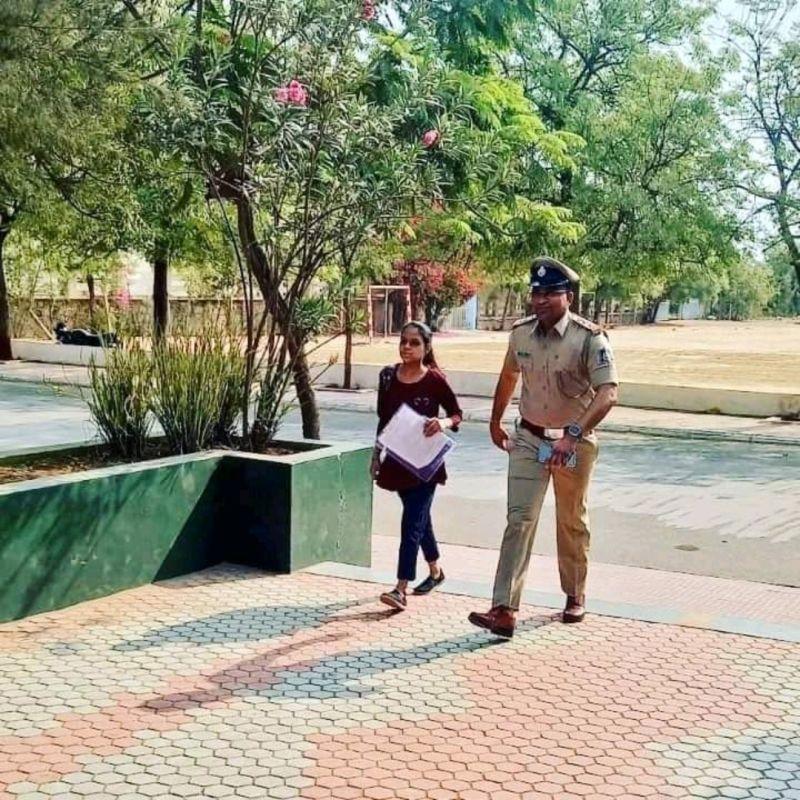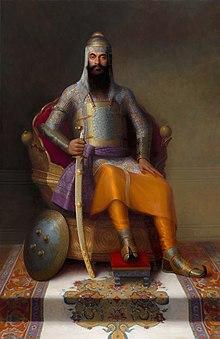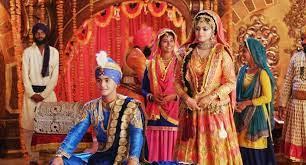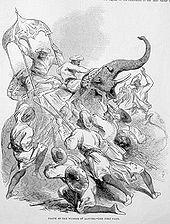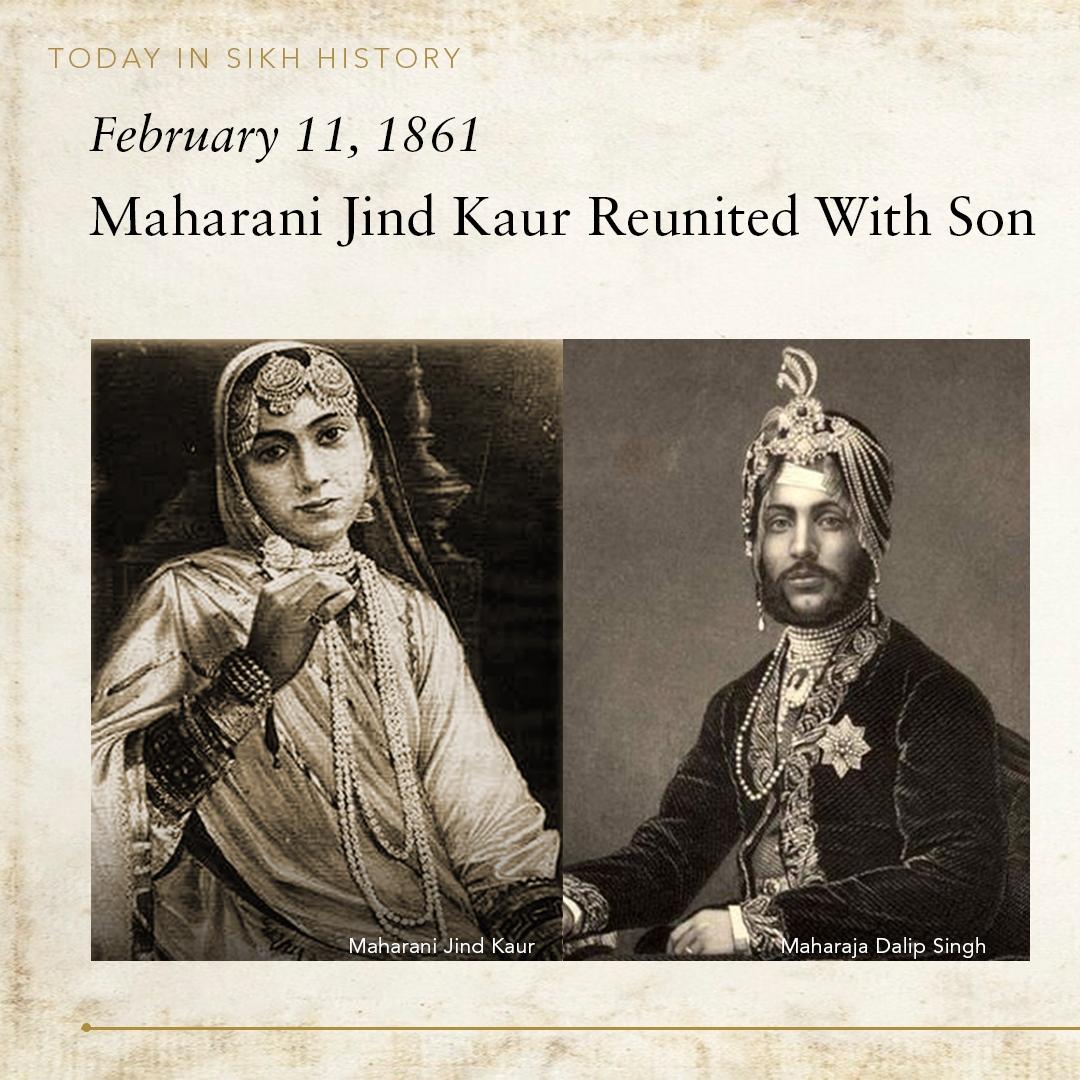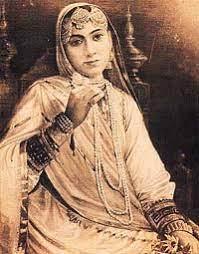Wives:
In 1789, Ranjit Singh married his first wife Mehtab Kaur, the muklawa happened in 1796. She was the only daughter of Gurbaksh Singh Kanhaiya and his wife Sada Kaur, and the granddaughter of Jai Singh Kanhaiya, the founder of the Kanhaiya Misl. This marriage was pre-arranged in an attempt to reconcile warring Sikh misls, wherein Mehtab Kaur was betrothed to Ranjit Singh in 1786. However, the marriage failed, with Mehtab Kaur never forgiving the fact that her father had been killed in battle with Ranjit Singh's father and she mainly lived with her mother after marriage. The separation became complete when Ranjit Singh married Datar Kaur of the Nakai Misl in 1797 and she turned into Ranjit's most beloved wife. Mehtab Kaur had three sons, Ishar Singh who was born in 1804 and twins Sher Singh and Tara Singh born in 1807. According to historian Jean-Marie Lafont, she was the only one to bear the title of Maharani. She died in 1813, after suffering from a failing health.
His second marriage was to, Datar Kaur (Born Raj Kaur) the youngest child and only daughter of Ran Singh Nakai, the third ruler of the Nakai Misl and his wife Karmo Kaur. They were betrothed in childhood by Datar Kaur's eldest brother, Sardar Bhagwan Singh, who briefly became the chief of the Nakai Misl, and Ranjit Singh's father Maha Singh. The anand karaj took place in 1792 and the muklawa happened in 1797; this marriage was a happy one. Ranjit Singh always treated Raj Kaur with love and respect. Since Raj Kaur was also the name of Ranjit Singh's mother, she was renamed Datar Kaur. In 1801, she gave birth to their son and heir apparent, Kharak Singh. Four years later she gave birth to another son, Rattan Singh. Like his first marriage, the second marriage also brought him strategic military alliance. She was exceptionally intelligent and assisted him in affairs of the State. During the expedition to Multan in 1818, she was given command alongside her son, Kharak Singh. Throughout her life she remained Ranjit Singh's favorite and for no other did he have greater respect for than Datar Kaur, who he affectionately called Mai Nakain. Even though she was his second wife she became his principal wife and chief consort. During a hunting trip with Ranjit Singh, she fell ill and died on 20 June 1838.
Ratan Kaur and Daya Kaur were wives of Sahib Singh Bhangi of Gujrat (a misl north of Lahore, not to be confused the state of Gujarat). After Sahib Singh's death, Ranjit Singh took them under his protection in 1811 by marrying them via the rite of chādar andāzī, in which a cloth sheet was unfurled over each of their heads. The same with Roop Kaur, Gulab Kaur, Saman Kaur, and Lakshmi Kaur, looked after Duleep Singh when his mother Jind Kaur was exiled. Ratan Kaur had a son Multana Singh in 1819, and Daya Kaur had two sons Kashmira Singh and Pashaura Singh in 1821.
Jind Kaur, the final spouse of Ranjit Singh. Her father, Manna Singh Aulakh, extolled her virtues to Ranjit Singh, who was concerned about the frail health of his only heir Kharak Singh. The Maharaja married her in 1835 by 'sending his arrow and sword to her village'. On 6 September 1838 she gave birth to Duleep Singh, who became the last Maharaja of the Sikh Empire.
His other wives included, Mehtab Devi of Kangara also called Guddan or Katochan and Raj Banso, daughters of Raja Sansar Chand of Kangra.
He was also married to Rani Har Devi of Atalgarh, Rani Aso Sircar and Rani Jag Deo According to the diaries, that Duleep Singh kept towards the end of his life, that these women presented the Maharaja with four daughters. Dr. Priya Atwal notes that the daughters could be adopted. Ranjit Singh was also married to Jind Bani or Jind Kulan, daughter of Muhammad Pathan from Mankera and Gul Bano, daughter of Malik Akhtar from Amritsar.
Ranjit Singh married many times, in various ceremonies, and had twenty wives. Sir Lepel Griffin, however, provides a list of just sixteen wives and their pension list. Most of his marriages were performed through chādar andāz. Some scholars note that the information on Ranjit Singh's marriages is unclear, and there is evidence that he had many concubines. Dr. Priya Atwal presents an official list of Ranjit Singh's thirty wives. The women married through chādar andāzī were noted as concubines and were known as the lesser title of Rani (queen).While Mehtab Kaur and Datar Kaur officially bore the title of Maharani (high queen), Datar Kaur officially became the Maharani after the death of Mehtab Kaur in 1813. Throughout her life was referred to as Sarkar Rani. After her death, the title was held by Ranjit's youngest widow Jind Kaur.According to Khushwant Singh in an 1889 interview with the French journal Le Voltaire, his son Dalip (Duleep) Singh remarked, "I am the son of one of my father's forty-six wives." Dr. Priya Atwal notes that Ranjit Singh and his heirs entered a total of 46 marriages. But Ranjit Singh was known not be a "rash sensualist" and commanded unusual respect in the eyes of others. Faqir Sayyid Vaḥiduddin states: "If there was one thing in which Ranjit Singh failed to excel or even equal the average monarch of oriental history, it was the size of his harem." George Keene noted, “In hundreds and in thousands the orderly crowds stream on. Not a bough is broken of a wayside tree, not a rude remark to a woman”.
Wives:
In 1789, Ranjit Singh married his first wife Mehtab Kaur, the muklawa happened in 1796. She was the only daughter of Gurbaksh Singh Kanhaiya and his wife Sada Kaur, and the granddaughter of Jai Singh Kanhaiya, the founder of the Kanhaiya Misl. This marriage was pre-arranged in an attempt to reconcile warring Sikh misls, wherein Mehtab Kaur was betrothed to Ranjit Singh in 1786. However, the marriage failed, with Mehtab Kaur never forgiving the fact that her father had been killed in battle with Ranjit Singh's father and she mainly lived with her mother after marriage. The separation became complete when Ranjit Singh married Datar Kaur of the Nakai Misl in 1797 and she turned into Ranjit's most beloved wife. Mehtab Kaur had three sons, Ishar Singh who was born in 1804 and twins Sher Singh and Tara Singh born in 1807. According to historian Jean-Marie Lafont, she was the only one to bear the title of Maharani. She died in 1813, after suffering from a failing health.
His second marriage was to, Datar Kaur (Born Raj Kaur) the youngest child and only daughter of Ran Singh Nakai, the third ruler of the Nakai Misl and his wife Karmo Kaur. They were betrothed in childhood by Datar Kaur's eldest brother, Sardar Bhagwan Singh, who briefly became the chief of the Nakai Misl, and Ranjit Singh's father Maha Singh. The anand karaj took place in 1792 and the muklawa happened in 1797; this marriage was a happy one. Ranjit Singh always treated Raj Kaur with love and respect. Since Raj Kaur was also the name of Ranjit Singh's mother, she was renamed Datar Kaur. In 1801, she gave birth to their son and heir apparent, Kharak Singh. Four years later she gave birth to another son, Rattan Singh. Like his first marriage, the second marriage also brought him strategic military alliance. She was exceptionally intelligent and assisted him in affairs of the State. During the expedition to Multan in 1818, she was given command alongside her son, Kharak Singh. Throughout her life she remained Ranjit Singh's favorite and for no other did he have greater respect for than Datar Kaur, who he affectionately called Mai Nakain. Even though she was his second wife she became his principal wife and chief consort. During a hunting trip with Ranjit Singh, she fell ill and died on 20 June 1838.
Ratan Kaur and Daya Kaur were wives of Sahib Singh Bhangi of Gujrat (a misl north of Lahore, not to be confused the state of Gujarat). After Sahib Singh's death, Ranjit Singh took them under his protection in 1811 by marrying them via the rite of chādar andāzī, in which a cloth sheet was unfurled over each of their heads. The same with Roop Kaur, Gulab Kaur, Saman Kaur, and Lakshmi Kaur, looked after Duleep Singh when his mother Jind Kaur was exiled. Ratan Kaur had a son Multana Singh in 1819, and Daya Kaur had two sons Kashmira Singh and Pashaura Singh in 1821.
Jind Kaur, the final spouse of Ranjit Singh. Her father, Manna Singh Aulakh, extolled her virtues to Ranjit Singh, who was concerned about the frail health of his only heir Kharak Singh. The Maharaja married her in 1835 by 'sending his arrow and sword to her village'. On 6 September 1838 she gave birth to Duleep Singh, who became the last Maharaja of the Sikh Empire.
His other wives included, Mehtab Devi of Kangara also called Guddan or Katochan and Raj Banso, daughters of Raja Sansar Chand of Kangra.
He was also married to Rani Har Devi of Atalgarh, Rani Aso Sircar and Rani Jag Deo According to the diaries, that Duleep Singh kept towards the end of his life, that these women presented the Maharaja with four daughters. Dr. Priya Atwal notes that the daughters could be adopted. Ranjit Singh was also married to Jind Bani or Jind Kulan, daughter of Muhammad Pathan from Mankera and Gul Bano, daughter of Malik Akhtar from Amritsar.
Ranjit Singh married many times, in various ceremonies, and had twenty wives. Sir Lepel Griffin, however, provides a list of just sixteen wives and their pension list. Most of his marriages were performed through chādar andāz. Some scholars note that the information on Ranjit Singh's marriages is unclear, and there is evidence that he had many concubines. Dr. Priya Atwal presents an official list of Ranjit Singh's thirty wives. The women married through chādar andāzī were noted as concubines and were known as the lesser title of Rani (queen).While Mehtab Kaur and Datar Kaur officially bore the title of Maharani (high queen), Datar Kaur officially became the Maharani after the death of Mehtab Kaur in 1813. Throughout her life was referred to as Sarkar Rani. After her death, the title was held by Ranjit's youngest widow Jind Kaur.According to Khushwant Singh in an 1889 interview with the French journal Le Voltaire, his son Dalip (Duleep) Singh remarked, "I am the son of one of my father's forty-six wives." Dr. Priya Atwal notes that Ranjit Singh and his heirs entered a total of 46 marriages. But Ranjit Singh was known not be a "rash sensualist" and commanded unusual respect in the eyes of others. Faqir Sayyid Vaḥiduddin states: "If there was one thing in which Ranjit Singh failed to excel or even equal the average monarch of oriental history, it was the size of his harem." George Keene noted, “In hundreds and in thousands the orderly crowds stream on. Not a bough is broken of a wayside tree, not a rude remark to a woman”.





